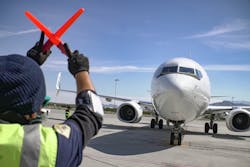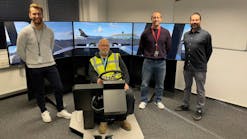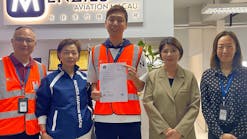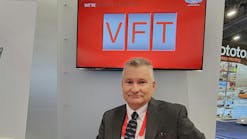Know the Rules
Aviation is an industry known for the speed at which it moves and its inherent risks. On the ramp, the risk is high and the rate at which rules, regulations and training moves is quick to ensure ground handlers are on top of the latest measures to ensure their wellbeing.
But how fast do the rules actually move and how do ground handlers keep up with the latest of their industry?
Guillaume Crozier, divisional vice president, operations and product development at dnata, says staying current is “an everyday task.”
“We are following the industry and IATA recommended framework such as the IATA Ground Operations Manual (IGOM) and IATA's Safety Audit for Ground Operations (ISAGO). Every year they're being refreshed and renewed. Beyond this, you have civil aviation regulation, airport regulation and customer requirements. There is a lot of regulation to be followed and for the sake of clarity and the big picture, it's changing constantly,” says Crozier.
dnata provides ground handling and cargo services at 88 airports in 14 countries around the world. . Last year, Crozier says dnata serviced around 700,000 aircraft turns. As a result, dnata works hard to ensure employees stay current – not only with industry and company standards but the myriad of global, local and regional regulations they operate to.
“It's a challenge, of course. We take it from various angles,” says Crozier. “First of all, it has to be a systemic approach in a sense that we have a robust processes in place to make sure that we are aware of and follow up on all the changes, from every stakeholder. We articulate our communication channels processes in a way that we can connect quickly, get the information out quickly and update our frameworks quickly.”
Crozier says that’s on the reactive side; on the proactive side, dnata is fully engaged in industry discussions and is part of working groups such as IATA and the Airport Services Association (ASA).
“We also actively participate in several industry forums throughout the year to really influence and also debate on what should be,” Crozier adds.
Staying Up to Date
ASA, a globally recognized trade association for the independent ground and air cargo handling industry, works to promote a safe, secure and sustainable future for the industry. As such, ASA plays a crucial role in helping to craft ground handling regulations, describes Fabio Gamba, ASA’s director general.
“We are very closely associated with the works of IATA, Airports Council International (ACI) or ICAO regarding standard-setting. ASA is also regularly informed and, at times, involved with the European Commission and, more specifically, European Aviation Safety Agency (EASA) regarding legislation that impacts ground handing,” Gamba says.
When it comes to making sure ground handlers are current with the latest safety standards of their industry, one of the challenges is disseminating that information throughout a company. Gamba says it’s important for the industry to have one single source of standard setting, and ASA recommends IATA’s safety standards and recommended practices.
“ASA closely collaborates with IATA and our inputs are reflected in the regular updates of the Airport Handling Manual (AHM),” says Gamba. “Ground handlers should be well aware of the IATA Ground Operations Manual. More generally, though, the best way to stay on top of any regulatory or standard developments is to join the community, as members receive updates regularly. Joining ASA is a no brainer for any GHSP, irrespective of size and location.”
ASA also pushes out the latest update through their social media accounts and newsletter and Gamba encourages ground handlers to subscribe for up to date information.
For dnata, Crozier says the process starts with technology.
“Innovation and communication is key to our success for us as an organization. And we have those 45,000 people across the network who depend on modern and reliable technology, good systems and sound processes. Safety is very important for us and we have two key focus areas, a safe place and a safe behavior,” Crozier says. “I will say to meet specific customer requirements, and the latest regulation changes, we consistently drive and focus on culture as a key enabler to ensure safe operations.
“We look for automation,” he continues. “We look on connection and interface between the HR and document management systems to make sure whenever an employee is starting their shift, they can quickly access the latest bulletin, read them and potentially ask questions if they are not clear with the assignment.”
Crozier adds that for employees who have been away from the job for a week or more, dnata has a policy that when the employee returns, they are given time to catch up on the latest news and be briefed by team leaders and supervisors.
Being worldwide, though, returns to the challenge of balancing industry-wide and regional regulations and standards. It’s a challenge the entire ground handling industry faces, Gamba says.
“The trickiest aspect of all, by far for a ground handling service provider, is when its employees are subject to different standards and practices from different airlines at a given airport. This includes questions of how many cones should be around the aircraft, how chocks must be set in place, and how many, for example. That makes consistent training quite difficult,” explains Gamba.
Striking between the two is dnata’s own manual for their employees – the minimum standard that the company expects its workers to follow.
“It’s a set of documentation starting with process maps, SOP, work instruction and training materials. These frameworks are being built with all of our SMEs across the network. We've invested a lot of time and effort with an aim to set high minimum standards for dnata. Of course, those minimum standards are IATA compliant and ISAGO compliant, but also bring in the best practices we see from each country,” Crozier explains.
He continues that dnata maintains a global framework, built on 80 percent of global requirements with the remaining 20 percent addressed through local operating procedures specific to the region dnata employees find themselves in.
“We are a risk-based organization so everything we do goes for risk assessment. That's really important for us,” Crozier adds. “Once you have your baseline and you receive any request, or change any specific local oversight program requirements, we can immediately identify the impact on our operation and through a collaborative review process including subject matter experts from safety, training, assurance and operations, we define requirements for adjustments in operational procedures to manage the risk to a level of ALARP.
In the near future, helping to smooth over some of the regional differences in Europe will be the EASA’s adoption of ground handling standards.
“From a regulatory perspective, the European Safety Agency, EASA, is amongst the only ones today that considers ground handling as being an essential element of air transport safety and that regulates it. They are currently putting the final touches to a Rule-Making Task that will shape European standards around such aspects as training. The International Civil Aviation Organization is also working on the drafting of its own standards and recommended practices,” Gamba explains.
“A brand-new legislation in the European Union on ground handling will be promulgated at the end of 2021 and an assessment of Directive 96/67/EC on a possible revision of market access should be conducted throughout 2020,” he adds. “There is also a review of Regulation 376/2014 on the reporting, analysis and follow-up of occurrences that is being considered by the European Commission and which may have an impact on ground handling service provider’s operations.”
Time for Training
Keeping up to date is crucial, but if not put into practice, merely knowing what the latest word on ramp safety is doesn’t do much. Employees need to be well-trained along with well-read.
“With increasing demands, improving training is becoming more crucial,” says Gamba.
Crozier says dnata’s training is, of course, a mandatory part of the job.
“There is a full matrix of mandatory training, which needs to be managed in a specific order from a safety and security point of view to make sure that we create a safe place and secure environment for people to operate in. This is supported with strong human resource process based on candidate profiling,” describes Crozier. “We have five types of jobs. So, depending on the type of job, we make sure we recruit the right people with key attitudes and behaviors. Once we have recruited the right people and they have completed all the mandatory training, received their passes, badges and clearance to move on, then we start with a mix of competence assurance elements and shadowing elements.”
Crozier says to help onboard new employees, dnata takes their most tenured and experienced employees and involves them to influence, coach and embed the soft skills, attitudes and culture which is the DNA of dnata.
Visible oversite on the ramp is key to the person-on-person element of training.
“Leadership oversight is very important to support competence development, especially on the ramp activity. As a company, we emphasize to all our supervisors and leaders the importance of visibility on the ramp to develop, coach and mentor on a continuous basis. We all use various technology platforms, but really developing the right culture and behaviors requires personal intervention.”
While leadership oversight is crucial to influence and ensures an employee is up to date and ready for the challenges of working on the ramp, the training itself is not without its hurdles to overcome.
“If you don't have the right system, it can become very bureaucratic. As an organization, we work hard to ensure databases are fully connected and intuitive to make it easier for everyone. The key challenge is the administration and making it as simple and digital as possible to ensure we can clearly demonstrate both our due diligence as well as the assurance that our employees have the right skills. As a global organization, I think we are moving in the right direction and always seeking new technology to support us in reducing cost associated with training while providing a high level of training that is easily absorbed by our workforce,” Crozier says.
As such, computer-based training is a crucial element to dnata’s training approach and they have various devices across their network to brief staff.
“We have various apps to help our people stay connected and share information,” Crozier says. “We have a document management system, as well, which is very important to help us to manage the tracking and manage the compliance aspects of our business. It also provides some assurance that the appropriate staff are receiving the relevant information and responding to the information provided. All of these suites of tools are required today to face the information challenge.”
Gamba adds that computer-based learning and the myriad of other technological innovations to the ground handling industry make for a more efficiently trained workforce, provided companies are able to take advantage of them.
“E-learning is another way for ground handlers to up-skill and expand their career progressions options. In fact, more electronic devices are available nowadays and are on the market to help employees operate safely on the ramp. One can think of the anti-collision devices that now equip most of the motorized ground service equipment (GSE). The technology is there, and it is fairly mature. The problem is, as often, related to cost and the investment it takes for a GHSP to get equipped. In a cut-throat competitive environment as ground handling is, a certain race to the bottom may impede the timely acquisition of these devices,” Gamba says.
Technology is set to have a growing role in the industry with training, with exciting applications on the horizon that are just now beginning to gain a foothold.
“There are some exciting virtual reality (VR) developments. IATA launched Ramp VR, a virtual reality ‘plug-and-play’ training platform, which is already being used in ground handling training processes. Training with virtual reality allows workers to simulate a range of situations that simply cannot be recreated for training purposes on the ramp, such as snowstorms and lightning strikes while providing a calm and secure environment where they feel comfortable making mistakes,” says Gamba.
Crozier says VR is an area that dnata is exploring.
“We are still looking at VR across all our services to explore the viability with the industry. We are not yet using it actively in production, but we can foreseeably recognize the benefits from it,” says Crozier. “When you think about it, you can start realistic and visual ramp training and retraining without actually being on the ramp, whereas we need to get the airport pass before starting physical training. With VR, you can visualize the steps and activities which would be more effective, efficient and supports higher retention of learning. Still, this will not replace on the job training, where you really have to put your people in the context of the operation. This still needs a bit of work, but from a logistics and reality training point of view, VR has the potential to be a very good tool.”








